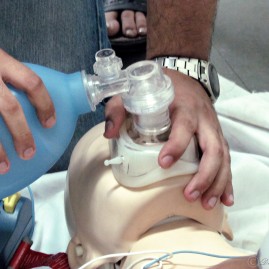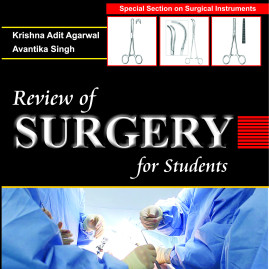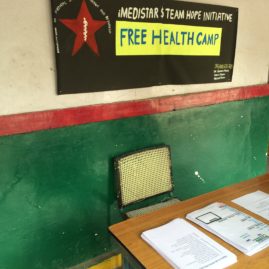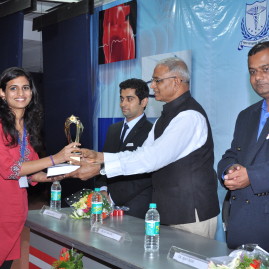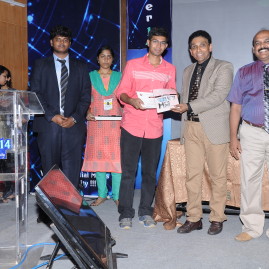What is Low Birth Weight?
– Birth weight of less than 2500 g (or 2.5 kg)
– According to World Health Organization – 25 million babies born every year worldwide have low birth weight
– 30% of all babies born in India have low birth weight
Why does it matter?
Being born with low birth weight carries a high risk for mortality and morbidity not only in the infancy period but also in later life. These babies have a harder time eating, gaining weight, staying warm, and fighting infection. They are also at risk for developmental delays and poor neurological outcomes. Low weight at time of birth can lead to high blood pressure, insulin resistance and high cholesterol when the child grows up.
What causes low birth weight?
Premature birth and poor fetus growth in the womb (intrauterine growth restriction)
What are the risk factors for having a low birth weight baby?
Smoking (by mother as well as other family members i.e. passive smoking)
Anemia in mother
Inadequate weight gain by mother
Poor nutrition with less protein in mother’s diet
Previous premature or low birth weight baby
High blood pressure in mother
Poor prenatal care
Can we predict low birth weight?
Prediction model developed for India at Safdarjung hospital, New Delhi, India [1]:
If any 3 factors are positive or if the total score is ≥30, then the likelihood of having a low birth weight baby are high.
| Yes/No | Points to be given if Yes | |
| Anemia in mother | 15 | |
| Poor nutrition with less protein in mother’s diet* | 15 | |
| Smoking (by mother as well as other family members i.e. passive smoking) | 10 | |
| Inadequate weight gain by mother ** | 10 | |
| Previous premature baby | 15 | |
| Previous baby with low birth weight | 15 | |
| Total |
- * Poor nutrition with less protein = <47 g protein per day in mother’s diet during the pregnancy
- ** Inadequate weight gain = <8.9 kg weight gain during pregnancy
- (The suggested cut-off score to predict LBW using this model is ≥25 with a sensitivity of 71.6 %, specificity 67.0 % )This scale is a result of a large case-control study done at Safdarjung Hospital, New Delhi, India. To build this model, 500 mothers of low birth weight newborns were interviewed and their medical charts were searched to develop and validate this unique prediction model. This model can predict low birth weight with a sensitivity of 71 % and specificity of 67 %. Some of the factors that predict low birth weight are preventable. Therefore, this scale is being used to counsel reproductive-age females. This work has been used by several international researchers who worked on low birth weight prediction models in other developing countries. These countries include China, Iran, Brazil, Indonesia and Democratic Republic of Congo.
- Singh A, Arya S, Chellani H, Aggarwal KC, Pandey RM. Prediction model for low birth weight and its validation. Indian J Pediatr. 2014;81(1):24-8. doi:10.1007/s12098-013-1161-1.
What can I do to prevent Low Birth Weight?
I am a reproductive age female:
– Focus on your nutrition: Eat a well balanced meal with adequate proteins, gain healthy weight during pregnancy, eat foods rich in iron
– Avoid smoking: Encourage your family members to quit smoking as passive exposure to smoke can also lead to low birth weight
– Get regular check-ups and blood tests before and during pregnancy
I am an obstetrician:
– Incorporate low birth weight counseling in your practice to encourage mothers to take care of their diet
– Continue to check blood iron level and prescribe iron supplements
– Counsel pregnant females regarding inexpensive sources of iron and proteins (cooking food in iron utensils, using jaggery, increased intake of lentils, nuts including peanuts, seeds, green leafy vegetables)
I am a school or college teacher or a youth leader:
– Incorporate healthy weight and anemia counseling for female students
– Organize health camps with annual weight check and blood hemoglobin testing
– Organize food counseling camps and activities to encourage increased protein intake with local and inexpensive food items (cooking food in iron utensils, using jaggery, increased intake of lentils, nuts including peanuts, seeds)
– Spread awareness and discourage tobacco smoking in both male and female students
I am a Government Agency:
– Increase protein and iron content of food distributed to reproductive agent females in schools, colleges, ‘Anganwadi’ program
– organize free health camps in schools, colleges, youth centers for annual health check-up with weight and hemoglobin monitoring
– Spread awareness and discourage tobacco smoking in youth
For further details and to conduct low birth weight counseling programs and camps, please contact Dr. Avantika Singh^ at avantika.sjh@gmail.com. Click below the picture to read more.
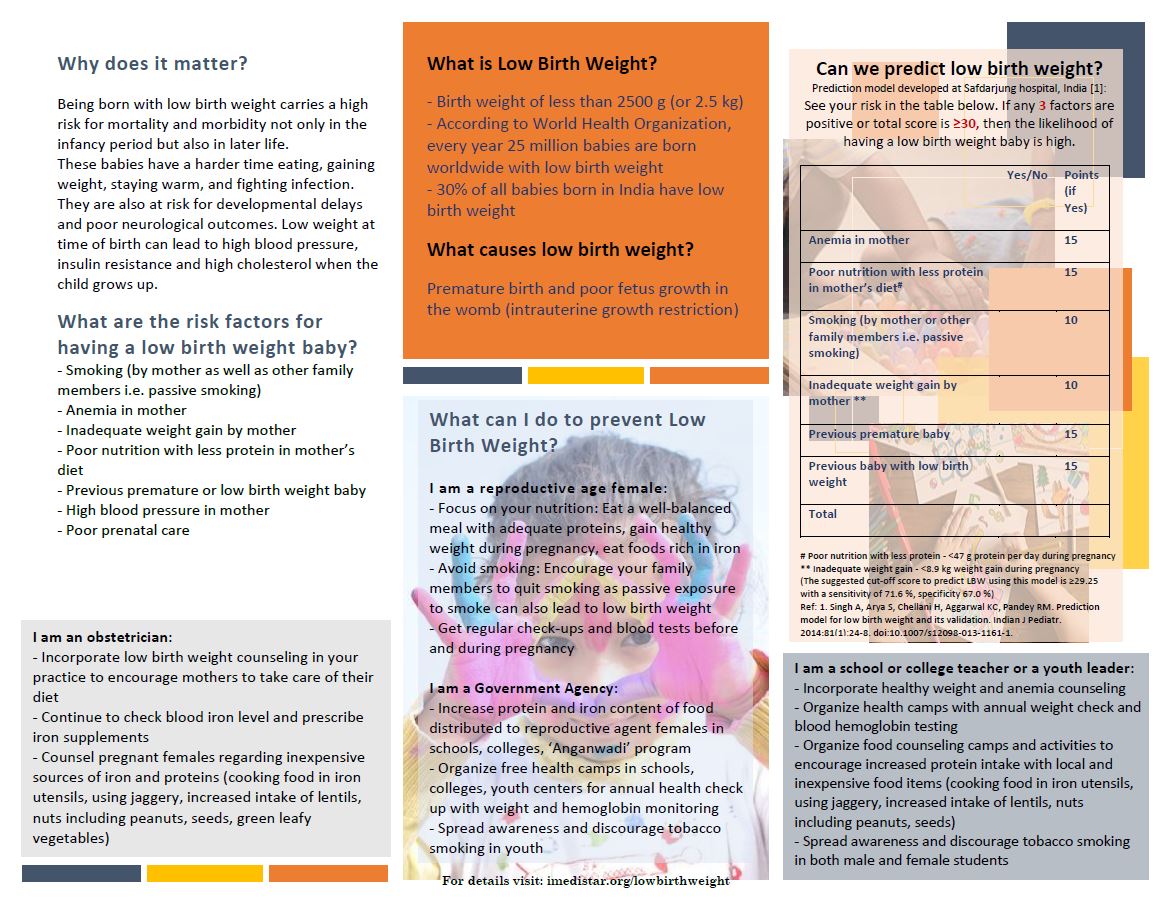
^Dr. Avantika Singh is currently a child neurologist in training at Boston Children’s Hospital, Harvard Medical School, USA. Prior to this, she completed her pediatric residency at Children’s Hospital of Wisconsin, Medical College of Wisconsin, USA and served as a Post-doctoral Clinical Research Fellow in Neonatal Neurology at Boston Children’s Hospital, Harvard Medical School, USA. She is an academician par excellence as she has won numerous honors and awards for excelling in her studies including securing the top position in her class in medical school at VMMC, Safdarjung Hospital, New Delhi, India.
During her medical school, she learnt about the significant impact of low birth weight and performed research in this area. Being born with low birth weight carries a high risk for mortality and morbidity not only in the infancy period but also in later life. Despite the significant impact of low birth weight, there was no literature published on its prediction in the developing countries. Therefore, Dr. Avantika Singh designed and performed a case-control study, interviewed 500 mothers of low birth weight newborns and searched through their medical chart to develop and validate a unique prediction model. This model can predict low birth weight with a sensitivity of 71 % and specificity of 67 %. Some of the factors that predict low birth weight are preventable. Therefore, this scale is being used to counsel reproductive-age females. This work has been used by several international researchers who worked on low birth weight prediction models in other developing countries. These countries include China, Iran, Brazil, Indonesia and Democratic Republic of Congo.
She is a proficient author dedicated to the field of medical education for both medical students as well as patients. Due to her passion for medical education, she co-founded the first-ever Medical Students’ International Conference (MEDSICON), an international academic fest striving to provide a previously unavailable opportunity to medical students to present their research work and take it forward under the guidance of stalwarts of medicine. Her keen interest in promoting innovation and discovery in medical science led her to envision and launch I-MediSTAR (Innovation in Medical Science, Technology and Research) which provides a unique platform for medical students and graduates to share and develop their exceptional ideas with the help of like-minded innovators. You can contact her at avantika.sjh@gmail.com.
 5164total visits,1visits today
5164total visits,1visits today

